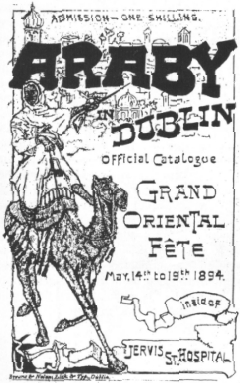
Since we are not really spending any more time with Joyce's "Araby" in class I will do a little blog on it to discuss it a bit further. In the back of my Viking Critical Edition there was one piece that specifically dealt with "Araby" (and about 5 that deal with "The Dead"). After reading the piece of background/ criticism on "Araby" by Harry Stone I found some really useful concepts that Stone puts forth to illuminate our reading of "Araby" and Joyce in general.
Stone mainly deals with the historical basis for "Araby" and also the job of Joyce inserting various allusions and symbolic meaning. While Stone goes into great detail about each of the historical background, allusions, & symbols' meaning, I will just give a simple rundown to sum up this piece and offer some new insight on the piece. Perhaps the most important statement that Stone makes is that Joyce "was careful to lacquer his images and actions with layer after layer of translucent, incremental meaning." This is one of the best ways to understand the collection of Dubliners.
The historical background in "Araby" is fairly present. Like the boy, Joyce himself grew up on North Richmond Street. Joyce and his character attended the same school and both "found it dull and stultifying". Also, it appears that characteristics of the boy's surrogate parents were inspired by Joyce's own parents. Not only do the boy and Joyce share many similarities but the bazaar itself had actually happened in 1894. In one of Stone's claims he says that it seems that "Araby" "is the identical struggle {to A Portrait of the Artist as a Young Man} at an earlier stage; "Araby" is a portrait of the artist as a young boy."
Stone also wants to assure us that beyond the historical foundations for the story lie the important lacquering of images mentioned earlier. Here is a list with a quick breakdown of important "meanings" to be grasped.
The Priest & house-- The death of the priest and the withering of a "central appletree" suggest a decay in the Catholic religion. Also the books the boy sees in the priest's death-room are full of meaning (too much to go in to here).
The girl (Mangan's sister)-- Stone says "all women, for Joyce, are Eves: they tempt and they betray". Stone suggests that Mangan's sister is a sort of false Madonna that is actually leading the betrayal and decay of Catholic religion (furthering the last theme).
Silver Bracelet-- Mangan's sister twirls a silver bracelet around her wrist suggesting an idolatry of mammon. The silver bracelet will come back about in the florin the boy carries to Araby.
Araby-- The uncle says how the word "araby" reminds him of a poem that he is going to recite. It turns out that the poem is about betrayal. The Arab's Farewell to His Steed begins with "My beautiful, my beautiful! that standeth meekly by,/ With thy proudly-arched and glossy neck, and dark fiery eye!/ Fret not to roam the desert now with all thy winged speed;/ I may not mount on thee again!-- thou'rt sold, my Arab steed!"
Florin-- The florin coin, or "flower" named because of the presence of the flower represented by the Virgin Mary, the boy clutches is actually the English production which became known as the "Godless and Graceless Florin". The coin itself recalls the silver bracelet the girl wears and also suggests betrayal of the Virgin Mary and Ireland itself.
I have left out mention the last epiphany on purpose. This blog was meant to show the "ooh's" that fill the story and not the "ah!". It is simply astounding to see how Joyce sets up the story with these layers of images (which I barely scratched). It is extremely evident how he could have progressed from these stories to Finnegan's Wake. Getting a further working knowledge of how Joyce structures his stories will reveal the epiphanies to us in more force.

No comments:
Post a Comment